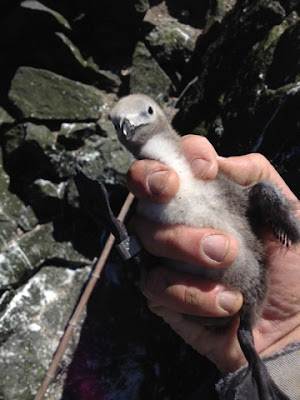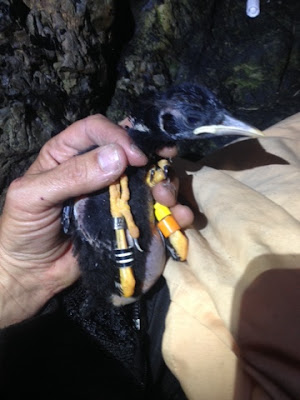The first high was the site, as this part of the north Cornwall coast really is quite stunning! The birds are best viewed from across a narrow isthmus looking back into the colony, nesting along a series of narrow ledges across the sheer face.
The high was soon replaced with a low though, as on scanning through the colony it soon became apparent that a vast majority of the nests were empty, some with attendant adults, some abandoned. This has recently been one of the key sites in the county for Kittiwake and to see it so devoid of new life was quite depressing. The last few years have seen huge declines in Kittiwakes across the whole south of their range, so we're just hoping that the big declines in key sites in Cornwall are just temporary blips.
The next high came when scanning through the core of the colony, waiting for birds to stand or and shuffle to check them for rings. I was expecting to find one or two French-ringed bird, but found none. But far more interesting to me was a bird that leap out at me as having one of our rings from the Lizard (60km away)! Thankfully it wasn't too far away to read and it turns out that 'AL' has a far from mundane history. It was actually ringed as a chick on Gugh, on the Isles of Scilly, in 1999 and was recaught by us at Rinsey in June 2012, when we added one of our colour rings. It was then seen three more times at Rinsey in 2012, six times in 2013 and just once in 2014 which was the year the colony crashed there. So we don't really know when it first moved to Porthmissen, but it is certainly one to look out for there in future.
The next high came when scanning through the core of the colony, waiting for birds to stand or and shuffle to check them for rings. I was expecting to find one or two French-ringed bird, but found none. But far more interesting to me was a bird that leap out at me as having one of our rings from the Lizard (60km away)! Thankfully it wasn't too far away to read and it turns out that 'AL' has a far from mundane history. It was actually ringed as a chick on Gugh, on the Isles of Scilly, in 1999 and was recaught by us at Rinsey in June 2012, when we added one of our colour rings. It was then seen three more times at Rinsey in 2012, six times in 2013 and just once in 2014 which was the year the colony crashed there. So we don't really know when it first moved to Porthmissen, but it is certainly one to look out for there in future.
After that quite special high, I was then plunged into a rather depressing low with the arrival of a juvenile (female?) Peregrine. After a short while visiting empty parts of the colony, it then happened upon a ledge with four nests on it, all with attendant adults. The first brooding Kittiwake put up quite a fight, but with the adults soon displaced, the Peregrine proceeded to jump from nest to nest along the ledge, taking all four chicks from these nests (all were broods of one) over 45 minutes. The first three were eaten at the nest, with only feeble mobbing from the parents, though one adult did manage to knock the Peregrine off the ledge, which then carried the last chick off to the clifftop to eat.
Whether this is a new behaviour or a regular occurrence is unknown, but this may go part way to explain why there were so many empty nests in other parts of the colony. That's nature though, even if it is mightily depressing!
 |
| Juvenile Peregrine predating the first of the four Kittiwakes nests in this photo, with other attendant adults unable to intervene |
Whether this is a new behaviour or a regular occurrence is unknown, but this may go part way to explain why there were so many empty nests in other parts of the colony. That's nature though, even if it is mightily depressing!

















